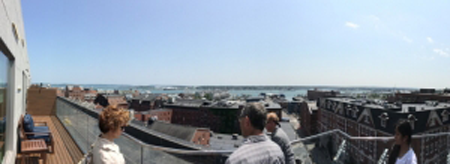December 18, 2016
Urban Conditional: May the New Year bring back basic needs for everyone
by Zack Barowitz

Housing was the issue in Portland for 2016. In fact, it was also the issue of 2015.
2015 Redux
Late in the year, the Portland Press Herald ran a series of stories on the housing shortage declaring the situation a crisis. If you would like to review their "No Vacancy" series, pretty much any subsequent Press Herald article links to it. The series raised awareness.
The coverage coincided with a referendum on the development of 58 Fore Street, a ballot measure that was ostensibly about preserving harbor views but ultimately became about development. The debate was heated, emotional, polarizing, and (at least for the winning side) costly. Ultimately, the measure was defeated soundly, clearing a path for the redevelopment of the Portland Company Complex. This marked the first real victory for development after a string of defeats including the equally divisive Congress Square Park referendum (whose developers used the same PR consultants). Much of the force of the argument was that the development would add to the housing supply — a proposed 638 units.
Evictions
Meanwhile, in neighborhoods like Parkside and Libbytown — on the fringes of downtown — word got out that mass evictions (or “non-renewal of month-to-month leases”) were taking place. Many started to worry that Portland was destined to be like Vancouver or San Francisco, a place for only the very rich and very poor, with ever-escalating real estate prices. Social service agencies like Preble Street and an ad hoc coalition of groups demanded emergency action.
The Strim
In 2015's rematch of the previous mayoral election, second place finisher Ethan Strimling defeated incumbent Mike Brennan. Strimling’s campaign message was “Bring Portland Together,” but he mostly kept silent and allowed Brennan’s ineffectiveness and unpopularity with City staff and Council carry the day.
To address the housing crisis, Strimling expanded the the Council Housing Committee to five members. After several large public meetings and shortly before the committee presented the Housing Insecurity Package (a series of modest renter protections designed not to inhibit development), Strimling jumped in with a more aggressive set of protection policies. At which point, two of the attorneys on the Council, Jon Hinck and Spencer Thibodeau (who specializes in real estate), tried to salvage the situation with a series of compromise amendments, only to be voted down by the full council. In her blog, councilor Belinda Ray rejected several amendments as either redundant or “illegal,” stating that they replicated or contradicted state law. The original package passed and this year the committee was quietly restored to the traditional three members.
By the end of the year, Mayor Strimling's woes with council and staff were similar to that of his predecessor, but much better publicized — charter reform anyone?
Gentrifucked
Gentrification is the process by which demand for upscale housing outstrips supply. This leads to the development of luxury housing and the refurbishment of workforce and affordable housing, leading to displacement. The past three years have been a pretty good case in point. Real estate prices have been rising despite Portland’s population remaining flat (for about 20 years), and a relative boom in housing construction — much of it ongoing.
The causes and effects of gentrification include: low-income people replaced by higher-income people, fewer people occupying larger units, redlining (the practice of selectively raising prices on targeted demographics, often people of color), units purchased as second homes, and units being turned into Airbnb shell apartments. The sad reality is that due to the high costs of new construction (particularly land and labor costs), new units are necessarily priced at the high end of the market, or heavily subsidized.
Demand for high-end units remained strong through the spring and summer rental season as there was no discernable decrease in price due to the increased supply.
What's next year going to look like?
Despite the high prices, political dysfunction, and divided population, there are hopeful signs.
With hundreds of more units popping up, prices are sure to flatten, if not drop.
-
City planning staff seems to understand the situation and are always willing to talk with citizens.
-
A regional and Transit Oriented Development (TOD) approach to housing is gaining traction. Better public and alternative transportation networks will make off-peninsula neighborhood centers and thoroughfares denser and more attractive.
-
While not everyone is on board with Transit Oriented Development, a recent report co-sponsored by USM Muskie School, Portland Society for Architecture (PSA), Portland Regional Chamber of Commerce (PRCC), and Creative Portland (CP) recommended a regional approach to providing new affordable/workforce housing. Although the report itself was uneven and a little sloppy (e.g., one of the study areas, St. John Valley, was incorrectly identified as “St. John’s Valley”) it is significant insofar as groups that in past years had not given much thought or voice to housing policies (PSA, CP) or have not been known for being champions of progressive causes (the Chamber) could agree upon, or at least co-sign, a set of forward-thinking recommendations..
Transit Oriented Development could be at the center of policies that encourage affordable workforce housing, but questions remain: Will the development dollars be there? Will off-peninsula neighborhoods embrace a denser, more walkable environment? Will new arrivals to these areas be willing to take the bus?
And there are other measures that city government could take to reduce the cost of home ownership, and the overall cost of living, but unfortunately, I’ve reached my word limit for 2016. Happy New Year; may it provide basic needs for all.